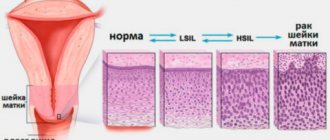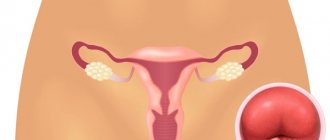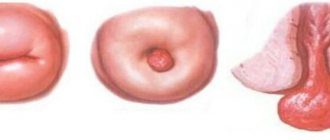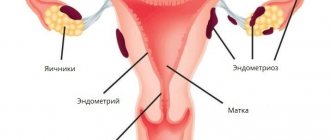Cervical erosion is an inflammatory process that affects epithelial cells, causing vaginal discharge and bleeding during sexual intercourse, between menstruation.
It is this diagnosis that is the most common reason for seeking help from a gynecologist, but in the early stages of its course it is perfectly treatable.
Stages of erosion development
In its course, erosion goes through several stages:
- Progressive - at this stage, glandular structures of the same type are formed on the mucous membrane of the cervix, and the uterine epithelium also grows.
- Stationary stage - in this case, the neoplasm itself develops on the surface of the cervix, which gradually increases in size and grows.
- Healing stage - occurs after inflammation subsides and cysts may persist.
Stages of pseudo-erosion
- Glandular
- in which cylindrical epithelial cells grow beyond the area of their normal location and form erosion zones. The duration of this stage can reach several years. - Papillary
- during this period, on the emerging lesions with pathological tissue, in addition to glandular tissue, papillary formations consisting of connective tissue (cervical cells) are formed. During this period, a diagnosis of glandular-papillary pseudoerosion is made. - Squamous cell metaplasia
- at this stage, the squamous epithelium is restored and grows, resulting in the formation of several layers. This stage is also called glandular-cystic pseudo-erosion of the cervix. A complication at this stage may be the formation of “alarm cysts” due to the fact that the formed glands may overlap. The mucus formed in the cysts cannot be eliminated naturally. As a result, the glands swell and form cavities. This circumstance increases the risk of organ infection.
According to the nature of development of pseudo-erosion there are:
- Progressive
- the process develops sequentially: epithelial cells grow, glands are formed, glandular tissue is replaced by warty growths of cervical cells, cavities (cysts) are formed, and inflammation occurs. - Stationary
- at the stage of formation of nabothian cysts, the process goes in the opposite direction: inflammation disappears, squamous epithelium is restored, columnar cells are replaced by normal ones. However, not all cysts disappear. Cavities up to 3 mm in diameter remain. This leads to an increase in the size of the neck and its deformation. - Healing
– the pathological tissue (cylindrical cells) is completely replaced by healthy ones. The cysts disappear. There is a complete restoration of the normal structure of the epithelium.
Why is erosion dangerous?
Often women who have been diagnosed with this by a gynecologist ask the question: why is cervical erosion dangerous?
And before considering it, it is worth understanding what the doctor means by the medical term erosion. If so-called pseudo-erosion is diagnosed, this condition is not considered dangerous for a woman.
If a true type of erosion is diagnosed, it is dangerous for it and, first of all, it is worth diagnosing its root cause. It is the reason for the appearance of erosion, the state of its course that will determine the level of its danger.
If the origin of erosion is infectious, there is a risk of damage to the uterus and its appendages, serious sepsis and, ultimately, female infertility. But in most cases, the pathology is erosion that affects the cervix and provokes the development of vaginitis and endometritis. The most dangerous is erosion that affects the cervix during gestation, as it can cause a miscarriage.
This list of dangers that erosion can pose is not complete and it all depends on the general health of the woman, her immunity, the functioning of internal organs and systems that accompany the pathologies associated with erosion.
What is it and how does it appear
The diagnosis of cervical erosion is made to almost every second patient at an appointment with a gynecologist. In general, the disease is one of the most common pathologies in women of childbearing age. But what is cervical erosion? This is a violation of the integrity, defect or covering with ulcers of the mucous membrane in the vaginal part. Erosion becomes a gateway for infection to enter the uterus and appendages and can provoke the development of chronic inflammatory diseases of the pelvic organs, including infertility. The most dangerous complication of cervical erosion is its degeneration into a malignant formation. This is why it is so important to identify it as soon as possible.1
There are many causes and provoking factors for the occurrence of this disease, but the main ones are: 2
- hormonal disorders and decreased immunity, disruptions in the menstrual cycle;
- too early onset of sexual activity, as well as early pregnancy and childbirth;
- frequent change of sexual partners;
- poor personal hygiene;
- mechanical trauma as a result of difficult childbirth, abortion and other medical procedures; due to incorrect use of vaginal contraceptives or douching, or too rough sex;
- inflammatory and infectious diseases of the genitourinary area, including their untimely and improper treatment;
- bacterial and viral diseases;
- unfavorable heredity.
Types of erosion
There are the following types of cervical erosion:
- True type of erosion. It is what forms on the walls of the cervix due to damage and desquamation of the epithelium lining the cervix. This type is characterized by neoplasms marked by the first signs of inflammation. It is also characteristic of it and the discharge shows itself during the development of endocervitis and the true erosion itself has an irregular rounded shape, a bright red color and often bleeds at the slightest irritation. This type of erosion is diagnosed during a colposcopic examination by a gynecologist - the doctor observes dilated blood vessels and painful swelling of tissues, as well as traces of fibrin and purulent, interspersed with blood. In the absence of timely diagnosis and treatment, it will develop into the stage of pseudo-erosion.
- Pseudo-erosion - in this case, the cells are replacing the defect of the flat type of epithelium with its cylindrical shape and the erosion itself will acquire a bright red color. At this stage, the growth of the cylindrical type of epithelium occurs both on the surface and in its deeper layers. In the erosive glands themselves, a secretion is formed and if there are problems with its outflow, cysts are formed. As they grow, they can resemble polyps, but if there are too many of them, they become denser and subsequent hypertrophy of the cervix. Without attention and treatment, it can occur in a latent form for 3-4 months, provoking inflammation of the cervical cavity. If treatment is prescribed promptly and correctly, the cylindrical epithelial cells are replaced by healthy ones; if not, the woman may develop pathological processes of replacement of cervical epithelial cells. As a consequence, the development of atypia and dysplasia. In practice, doctors distinguish the following types of pseudo-erosion: Glandular - they are characterized by pronounced cystic neoplasms and glandular tracts in structure.
- Papillary type - marked by the appearance of papillary neoplasms on the surface of the epithelium and their growth and fusion, which is accompanied by an inflammatory process.
- Mixed type - marked by the characteristics of the species described above.
Complications
Cervical erosion is the most common female pathology. With cervical erosion, there is a high probability of proliferation of pathogenic bacteria, which can cause many dangerous diseases. This is how infections caused by sexual intercourse with an infected partner and pathogens of fungal diseases can enter the uterus. The main consequence is disruption of reproductive functions.
Another dangerous form of advanced erosion is cancer. Moreover, both the tissues of the uterus and nearby organs can be affected by malignant formations, as well as the mammary glands and other organs.
In total, medicine has identified 3 main pathologies of the cervix:
- Background (erosion) – the presence of mechanical damage on the mucous tissues of the cervix, as well as areas with altered epithelial structure;
- Precancerous (dysplasia) - a condition in which the cells of the cervix are replaced with atypical ones, and the number of layers of the epithelium lining the cervix also changes;
- Cancerous (cancer) – degeneration of epithelial cells and the formation of tumor areas occurs.
It is important to remember that precancerous and cancerous diseases of the reproductive system of women are often diagnosed with rare and irregular visits to the gynecologist. Pathologies at an early stage of development can be easily treated.
Causes of erosion
Regarding the reasons that can provoke the appearance of cervical erosion, doctors identify the following, the most common:
- Inflammation affecting the female genitourinary system, and endocervicitis occupies a special place in this list. The thing is that this provokes more active work of the glands, their excretory functions and frequent damage.
- Pathological processes occurring in the uterine cavity and accompanied by intense discharge - destroyed polyps and endometrium, which provoke desquamation, removal of the affected tissues lining the cervix.
- Injuries - after childbirth and operations, abortion and installation of a spiral, which violate the integrity of the epithelial layer, causing erosion.
- Hormonal imbalance - early or late puberty in a teenager, failure of menstruation and taking hormonal contraceptives, inflammation of the ovaries and pregnancy.
- Malfunction of the immune system that can provoke the development of erosion - most often this is a non-gynecological group of pathologies that can negatively affect the entire body, its internal organs and systems.
- During pregnancy there is a special development of the fetus, but this most often goes away on its own and does not require intervention from doctors.
Among the predisposing factors for the appearance of erosion affecting the cervix, doctors identify the following:
- Irregular sex life in a woman , marked by rare sexual contacts or too intense, with a change of sexual partner.
- Early sexual activity or too late debut has a negative impact on a woman’s entire body.
- Weakened immunity and frequent and unreasonable change of sexual partners , promiscuous sexual relationships.
Doctors also highlight the relationship between erosion, as a pathological process affecting the cervix, with some root causes:
- Abuse of alcohol and smoking - this provokes not only the emergence of dependence on tobacco and alcohol, but also a malfunction of many organs and systems.
- A woman’s hereditary predisposition - according to medical statistics, if doctors diagnosed erosion in a mother and grandmother, then the patient’s risk of developing it increases by 30%.
- Taking hormonal contraceptives by a woman , although such a relationship has not yet been established, nevertheless, it is not excluded by specialists as such.
- Among other things, a predisposing factor is poor ecology , as well as poor nutrition - factors predisposing to the appearance of erosion.
- Sleep disturbances and a sedentary lifestyle - such reasons can provoke negative phenomena in the uterine cavity and its cervix.
In some cases, women who have not previously given birth or had an abortion may experience erosions. As doctors note, they appear for no apparent reason and also go away on their own, without medical intervention. Such phenomena are caused by physiological processes and stress occurring in a woman’s body, climate change and other external factors.
Erosion during pregnancy
The appearance of ectopia during pregnancy is a consequence of changes in a woman’s hormonal levels, a decrease in immune defense, and does not require special treatment. The danger lies in possible complications. The affected areas of the cervix do not perform a protective function, so the threat of infection and the occurrence of an inflammatory process increases. The doctor chooses the most gentle medications allowed during pregnancy.
Prevention of complications is to follow the rules of personal hygiene and use condoms during sexual intercourse.
Injuries during childbirth can cause true erosion. Against the background of recovery processes and the removal of lochia, the disease goes unnoticed by the young mother.
Symptoms of cervical erosion
Cervical erosion in 9 out of 10 cases is marked by latent symptoms and, if they show themselves, they are very scant.
Therefore, the pathology itself is often detected by chance, during an examination by a gynecologist, and if we talk about indirect symptoms, doctors call the following as such:
- If cervical erosion is uncomplicated, a woman’s vaginal discharge may increase. This is due to an increase in the cylindrical epileptic type of cells and, accordingly, vaginal discharge.
- Painful sensations in the lower abdomen during a woman’s menstrual cycle may also indirectly indicate the development of cervical erosion.
- A feeling of heaviness in the lower abdomen and discharge with an unpleasant odor , intensifying during/after sexual intercourse.
- Also, the development of erosion can provoke a disruption of the menstrual cycle.
If cervical erosion is diagnosed in an advanced form, the discharge may be thicker, more viscous, interspersed with pus and blood.
Prevention
The main thing here is proper adherence to the rules of personal hygiene using special antiseptics. Hygiene is especially important during menstruation. For this purpose, you can use Ginocomfort intimate washing gels. They were created by specialists from the pharmaceutical company VERTEX and have the necessary documents and quality certificates.
Other measures to prevent erosion include the following:
- regular gynecological examination (at least once a year);
- safe sex life (if you change partners frequently, be sure to use condoms to help protect against infections);
- refusal of abortions, which injure the surface of the cervix, causing erosion and inflammation.
As a prophylactic agent, you can use the Intimate Restoring Gel GINOCOMFORT®. It has an antimicrobial and anti-inflammatory effect, promotes the normalization of the natural microflora of the vagina and the rapid healing of microdamages. The product was developed by specialists from the pharmaceutical company VERTEX, passed clinical studies at the Department of Dermatovenereology with the clinic of St. Petersburg State Medical University and has all the necessary documents and certificates.
is not responsible for the accuracy of the information presented in this video clip.
Source - Live Healthy! Sources:
- CERVICAL EROSION. Makhatova G.M., Soboleva O.V. // Bulletin of surgery of Kazakhstan. – 2011. – No. 3. – P. 74-75.
- PREVALENCE AND CLINICAL FORMS OF CERVICAL ECTOPY AMONG WOMEN OF REPRODUCTIVE AGE. Ogrizko I.N., Semenov D.M. // Bulletin of Vitebsk State Medical University. – 2013. – No. 3. – pp. 73-77.
- Diseases of the cervix in pregnant women. Diagnosis, treatment, monitoring, prevention: P. S. Rusakevich, T. M. Litvinova // St. Petersburg, Medical Information Agency. - 2006 - P. 144.
- Cervical erosion. Modern view on treatment and prevention. E. A. Gracheva // St. Petersburg, IG “Ves”. - 2005. - P. 128.
- Human papillomavirus infection in women and cervical pathology. To help the practicing physician: S. I. Rogovskaya // Moscow, GEOTAR-Media. - 2008 - P. 224.
- https://www.healthline.com/health/womens-health/cervical-ectropion
- https://realityandmyths.com/cervical-erosion/
- https://medicalj-center.info/diseases/cervical-erosion-treatment-effective-and-modern-methods.html
- https://www.britannica.com/science/cervical-erosion
Diagnostic methods
First of all, an examination is carried out on a gynecological chair and only after that the doctor makes a preliminary diagnosis - pseudo-erosion. Only after making a preliminary diagnosis does he refer for additional examination and tests.
Erosion can be diagnosed in the following ways:
- Doctors take a smear from the vagina to determine its microflora, as well as the presence of atypical cells.
- Donating blood for HIV and the presence of syphilis and hepatitis in the body.
- PCR is a diagnostic method that allows you to determine the presence of sexually transmitted diseases in the body.
- Colposcopy is a method of examining the condition of the cervical epithelium under a microscope.
- Collection of biological material using a biopsy - most often this analysis is carried out if malignant or benign neoplasms are suspected.
- A blood test for hormonal levels is necessary if a hormonal imbalance is suspected and is most often prescribed to adolescents who are overweight.
- To diagnose the inflammatory process , as well as endocrine pathological processes, the patient may be referred for an ultrasound scan of the pelvic organs.
Diagnosis of the disease
An accurate diagnosis is made based on a complete examination of the woman. The following methods are used during the examination:
Diagnostics
- Visual inspection with a mirror to identify changes in the mucosa. True erosion: the epithelial layer is bright red, bleeding is visible. False erosion: squamous epithelium is replaced by columnar epithelium. Simple erosion: the epithelial layer is smooth. Papillary: nipple outgrowths form on the mucosa.
- Colcoscopy. During the examination, a colcoscope is used, which allows you to examine and examine the affected areas under high magnification.
- Biopsy is performed in parallel with colcoscopy when a deep-seated lesion of the epithelium is detected. A piece of tissue is taken from the cervix for further histological examination.
Why do the ovaries hurt before menstruation - the norm and deviations
At the same time, the woman is recommended to undergo tests for:
- trichomonas, herpes, myco-ureaplasma, chlamydia
- study of flora
- HIV, hepatitis, syphilis
- determination of hormone levels
- urine examination
- detection of dysbacteriosis
A complete gynecological examination of a woman at least 2 times a year is a guarantee of her health.
Treatment of erosion
Treatment of erosion affecting the cervix involves taking into account many factors, and the main one is precisely the reason that provoked such a phenomenon. Eliminating the cause of pathology is the primary task of doctors.
Stages of treatment:
- When diagnosing sexually transmitted infections, the pathogen itself is eliminated by prescribing a course of antibiotics and antiviral drugs.
- After eliminating the cause , the doctor decides how to eliminate pseudo-erosion. In this case, the area of the lesion and the age of the patient are taken into account, whether she plans to give birth in the future, and so on.
- Modern treatment methods help remove erosion without consequences , which allows nulliparous women to have children in the future.
- The defect itself is eliminated at the beginning of the next menstrual cycle , when menstruation itself ends. But there is an exception here too - this is a treatment method through diathermocoagulation.
Prognosis for patients
The prognosis for identifying erosion is favorable if it is diagnosed in the early stages of its development and treated in a timely manner.
Erosion is dangerous in women of any age because it is a favorable (provoking) factor for the development of malignancy in this place.
In addition, cystic cavities, scars, and polyps very quickly form at the site of damage, which in the future significantly complicate the possibility of achieving the desired pregnancy.
That is why it is extremely important to treat erosion immediately after identifying the disease.
Treatment methods
Depending on the stage of development of cervical erosion, three main treatment methods are used: medication, local method and surgery.
Medication course
Doctors prescribe pills in the following cases:
- The patient was diagnosed with an infectious nature of the origin of the disease, provoking manifestations of the mucous membrane.
- She has a weakened immune system and a low level of body resistance to external negative factors.
- With hormonal imbalance and metabolic disorders in the body.
Fluconazole Acyclovir Polyoxidonium
Among the drugs, doctors most often prescribe the following:
- Antibiotics . They suppress the vital activity of pathogenic microflora, acting at the cellular level of bacteria and microorganisms. Among the antibiotics in the fight against erosion, the most often prescribed are: Acyclovir - its active substance is acyclovir and actively affects the herpes virus, affects the DNA structure and blocks the synthesis of its growth and development.
- Flamir and its active substance famciclovir, which is transformed in the body into penciclovir. This antibiotic gives effective treatment results when the body’s defenses are weakened, acting as an immunomodulator.
- Immunals with echinacea juice, which has a wide sector of action. Strengthens the immune system and helps suppress the growth and development of pathogenic microflora.
Local treatment
Regarding the local course of treatment , it is prescribed in combination with other methods, surgical and medicinal. It helps speed up the patient's recovery and restore damaged tissue.
Depantol Genferon
Most often, ointments and suppositories are prescribed - this course of treatment is carried out at home and involves the prescription of the following drugs:
- Genferon - vaginal suppositories that allow you to correct local immunity, counteracts by suppressing the growth and development of pathogenic microflora. The active components of the product help accelerate the regeneration and restoration of damaged tissues, relieving inflammation.
- Depantol is a drug with an antibacterial and regenerating effect, which suppresses the growth and development of pathogenic microflora and activates the processes of regeneration and recovery after cauterization.
In addition to local medications, douching is also indicated. Medicines are also added to the douching water. In addition to douching, doctors also prescribe the introduction of tampons soaked in medicinal solutions.
Surgical intervention
If drug therapy does not provide positive treatment dynamics, doctors resort to surgical methods. Such treatment methods today are painless and very effective and include cauterization.
Among the cauterization methods are the following:
- Diathermocoagulation is a method of cauterization with current. It is considered outdated, and also quite sick and traumatic.
- Cryodestruction is the treatment of cervical erosion using liquid nitrogen. A fairly effective method that involves freezing the pathological area and subsequent destruction of the affected cells.
- Laser vaporization is an effective and painless way to combat erosion, noted for its high accuracy. The downside is the high price.
- Coagulation using radio waves is the most promising and progressive radio wave method of combating erosion.
- Electroconization - it is used in the case of diagnosing a severe degree of cervical erosion, which will eliminate atypical cells even in the deep layers of the epithelium, and they will not appear again after some time.
- Elimination of erosion using ultrasound or chemical, as well as medicinal cauterization. In the latter case, doctors most often use a drug such as Solkovagin - it provokes tissue necrosis and the formation of a scab in the erosion zone, its subsequent death and the formation of a healthy layer of tissue.
Description of the method of cauterization of cervical erosion
The very name of the treatment method is “to cauterize the erosion,” and it is correct, from a medical point of view, to be called diathermocoagulation. It is based as a medical procedure on the influence of chemicals, cold, laser or ultrasound on the affected area of the epithelium. As a consequence, the destruction of affected cells and activation of the natural process of regeneration and restoration of the epidermal layer.
Most often, cauterization with electric current is used - but the method is outdated, since it provokes the appearance of burns and scars. If the pathology is advanced, diathermoconization is indicated, complete removal of the affected area. The procedure is quite popular due to its accessibility and cost, but the only disadvantage is its pain, and the recovery period is a month.
But for the most part, cauterization of erosion has its advantages:
- High rates of positive treatment - in 9 out of 10 cases, doctors diagnose erosion to be cured.
- The procedure itself is simple and affordable.
With all this, it is worth remembering the disadvantages of the cauterization procedure for cervical erosion:
- Formation of scarring at the site of cauterization - this may subsequently affect the quality of sexual life, causing pain during sexual intercourse.
- During childbirth, its opening is difficult - this is due to the same damage to the epithelial layer, scarring.
- Sudden bleeding is possible , as well as the formation of inflammation at the cauterization site - most often such bleeding occurs with the slightest injury and during sexual intercourse, during physical activity.
- If cauterization is performed incorrectly , infertility and inability to bear a child may develop.
What is the danger of untimely cauterization of erosion?
Despite the fact that cauterization of cervical erosion as a treatment method has its drawbacks, this course of treatment is considered a prerequisite for recovery. You should not practice independent treatment, which will aggravate the situation and provoke the woman to develop female type infertility, as well as provoke the development of malignant neoplasms and cancer.
Doctors also include the negative consequences of untimely cauterization of erosion affecting the cervix of the uterus by the appearance of pronounced scarring, which in the future will lead to many problems with conception and the natural process of childbirth.
To prevent the re-development of erosive tumors in the cervix, it is worth visiting a gynecologist regularly, every 3-6 months, and undergoing examination and examination. All this will make it possible to diagnose pathology in the early stages of its course and apply less traumatic treatment methods.
Recommendations after cauterization
The process of cauterization of erosion affecting the cervix is a serious surgical intervention and therefore it is worth following all recommendations after cauterization performed in a hospital setting. All this will minimize all negative consequences after cauterization and speed up the recovery process.
Doctors provide the following recommendations and advice:
- You cannot have sex during the first 1-1.5 months. The decision to return to normal sexual activity should be made after an examination in a gynecological chair by a gynecologist.
- Any excessive loads are also prohibited - you should not lift heavy objects and experience severe stress, which can subsequently provoke complications.
- After a moxibustion session, you should not swim in open reservoirs and pools for 2-3 months. And all hygiene procedures should be carried out in the shower or exclusively under running water, excluding bathing.
- It is also recommended to carry out local treatment after the cauterization procedure - use suppositories and methods from the arsenal of traditional medicine. This serves as an excellent prevention and subsequent prevention of erosion.
- Also, a woman should not plan pregnancy immediately after cauterization - in this case, doctors advise allowing the body to recover for 1-2 months, when the menstrual cycle has passed and the uterus and its cervix have cleared. And just before planning a pregnancy, you should undergo a doctor’s examination and examination to make sure that after erosion there are no complications after the intervention.
- Among other things, in the first month after cauterization, you should not, unless absolutely necessary, undergo a diagnostic procedure via ultrasound , during which the doctor uses a vaginal type of sensor.
- In addition, it is important to observe the rules of personal hygiene - underwear should be changed as it gets dirty, the pad should be changed regularly every 3 hours, which will not provoke the growth and development of pathogenic microflora and infection. With regard to underwear, it is worth making a certain clarification - you should choose only those that are made from natural fabrics and certainly not from synthetic materials.
- In the first 1.5-2 months, it is worth giving up bad habits , such as smoking and alcohol abuse, which can cause vascular spasms or their excessive dilation and internal bleeding.
- You should not abuse folk remedies for treating erosion and those that accelerate the process of regeneration and tissue repair. They can cause a burn and cause an infection, which will only aggravate the situation and the course of the disease. If you want to use methods from the arsenal of traditional medicine, you should first coordinate them with your doctor.
The presented rules are quite simple and easy to implement, and if followed, they will allow you to avoid the development of complications after cauterization and restore the woman’s body and her reproductive system in a short time.
Cervical erosion itself is a common phenomenon among patients in a gynecological office and, with timely consultation with a doctor, can be easily treated. With the correct selection of the treatment method, be it cauterization or a course of medication, the elimination of erosion occurs quickly and without negative consequences.
Pregnancy after cervical erosion
Impact on conceiving a baby
Quite often, women wonder how erosion can affect the process of conceiving a child? Erosion itself does not in any way affect the conception of a baby, since it is not reflected in the reproductive system of the female body.
But erosion itself can negatively affect the process of bearing a fetus, and if it is provoked by an imbalance in the hormonal background of the female body or a sexually transmitted disease, conception as such will not occur.
Is pregnancy possible after cauterization?
If a woman is diagnosed with cervical erosion, there are no problems with conception, unless the latter is caused by a hormonal imbalance or a diagnosis of an STD.
But if it is detected before pregnancy, at the planning stage, it is worth treating the erosion first, and only after thinking about the birth of the baby.
If a woman is diagnosed with erosion of a large area, the process of regeneration and tissue restoration proceeds slowly - the process of pregnancy planning itself should be delayed a little.
Even the most complex process of tissue regeneration and restoration takes time and can often take about six months.
Popular questions and answers:
- Can cervical erosion go away on its own? Erosion may well go away on its own, without any treatment. But this applies only to a certain age category of women and a certain type of pathology. Congenital ectopia of columnar epithelium can resolve itself; it disappears before the age of 23-26 without any outside intervention. Also, without treatment, gestational erosion in pregnant women, which occurs as a result of increased production of progesterone, can go away. Another possible option for self-removal of erosion is observed when the defect was caused by taking hormonal contraceptives. There are frequent cases of self-healing from true erosion caused by traumatic factors (for example, during douching or as a result of careless intimacy). However, when a defect forms as a result of a disease or inflammation in the body, it requires treatment and can lead to serious complications.
- Is it possible to get pregnant with cervical erosion? This kind of defect does not in any way affect a woman’s ability to reproduce, so it is possible to become pregnant with erosion. Sometimes patients believe that they could not conceive a child precisely because of ectopia, but in fact this is not the case. Pathology is only a consequence of a disease. It is the disease that caused erosion that can lead to problems with conception, for example, if a woman has inflammation of the uterus, ovaries, appendages, etc. After the cause of erosion is eliminated, conception will occur, and the cervical defect often resolves itself when the child appears to the light. If a woman has erosion, but no infectious or inflammatory processes are diagnosed, then she is able to conceive a child at any time.
- How quickly can you get pregnant after cauterization of erosion? Moxibustion does not affect reproductive function.
- Is it possible to give birth with cervical erosion? You can give birth with cervical erosion only if it is congenital. When there is acquired pseudo-erosion, before planning a pregnancy, it is necessary to get rid of all diseases of the genital organs, normalize hormonal levels, etc. In addition, the damaged surface of the cervix is a potential threat to the fetus, as it becomes an ideal environment for the colonization and reproduction of bacteria. That is why doctors recommend eliminating all types of erosion, except congenital, and only then planning conception. However, if it turns out that there is erosion, and the woman has already become pregnant, then this is not an indication for termination (except for third-degree dysplasia).
- Can cervical erosion develop into cancer? Erosion can lead to oncology only in the presence of HPV-oncogenic types, or the presence of HIV infection. Therefore, in case of erosion, it is necessary to take a PCR test for the human papillomavirus and do a colposcopy.
- Is it painful to cauterize cervical erosion? The procedure is painless, but a few days after it is performed, the woman may begin to experience discomfort. They are localized in the lower abdomen and are similar to the aching and pulling sensations that often occur on the first day of the menstrual cycle.
- They cauterized the erosion, but after 2 years it appeared again. What to do? You will need repeated treatment. Perhaps more radical. Of the existing methods, laser therapy gives the lowest percentage of relapses.
- I have watery discharge mixed with blood after cauterization of cervical erosion. This is fine? Yes. They can last a month after cauterization.
- How long can you not have sex after cauterization of cervical erosion? Approximately 4 weeks until bleeding completely disappears.
- Is it possible to have sex with erosion? Yes, you can.
- The doctor suggested cauterizing the erosion with liquid nitrogen. Will I have a scar on my cervix after the procedure? No, it won’t, this method does not leave scars, it can be recommended to nulliparous women planning a pregnancy in the next year.
Treatment of erosion with folk remedies
Traditional medicine also knows many ways to combat erosion. But even with all their naturalness and safety, they should be agreed with the attending physician and used exclusively as a supplement, but not the main method of treatment.
Bergenia Calendula Rosehip
Traditional medicine recipes:
- Application of calendula. Most often, the flowers of this plant are used as a tincture, which can be purchased at the pharmacy. It is this that should be diluted in water – 200 ml. take 1 tsp of warm, boiled water. tinctures and douching with this solution.
- Calendula oil - you can buy it at the pharmacy, or prepare it yourself. It is enough to pour 20 grams of plant color into 200 ml. any vegetable oil and leave for 2 weeks, strain - soak a tampon with it and insert it into the vagina, leaving it overnight.
- Treatment of erosion with sea buckthorn oil - soak a tampon with it and also insert it into the vagina, leaving it overnight. The course of treatment is 10-14 days, depending on the stage and severity of the erosion. Sea buckthorn fruit oil acts as a natural antibiotic and wound healing agent, softens and relieves inflammation.
- As a remedy, use rosehip oil, which also helps to speed up the healing of erosion. They also soak a tampon and insert it into the vagina, leaving it overnight. As practice shows, after 7-10 sessions of such oil applications, erosion is delayed.
- To enhance the effect, you can take orally a collection of rose hips , St. John's wort, chamomile and calendula - it can be brewed as tea and taken no more than 3 cups per day.
- Effective treatment of cervical erosion and propolis. It can be used in the form of an ointment, which is sold in a pharmacy, or an alcohol tincture, which is diluted in water and, after soaking a tampon, is inserted into the vagina for 2-4 hours.
- Bergenia is an effective plant that has pronounced antibacterial and wound-healing properties. It is enough to mix 3 tbsp. l. mixed and ground rhizomes in water - just take 1 glass, boil over low heat and then use for douching or soak a tampon with it and make medicinal deposits inside.
Consequences of cervical erosion
If a woman is diagnosed with cervical erosion of a large area, doctors call the negative consequences the creation of favorable conditions for the development and functioning of pathogenic microflora. As a consequence, the development of many serious diseases that are infectious or fungal in origin.
- Most often, infection occurs with fungal microorganisms and chlamydia, Trichomonas - they can enter the uterine cavity, appendages and ovaries through the erosive hole. This, in turn, provokes the inability to conceive - female type infertility and the inability to conceive and bear fruit.
- Another negative consequence that can be caused by erosion that affects the mucous membrane of the cervix is cancer, a neoplasm that is malignant in nature. To prevent the development of such situations and diagnoses, a woman should regularly visit a gynecologist, undergo an examination every 3-6 months, all the examinations and tests prescribed by him, and a full course of treatment.
Complex surgical procedures in the treatment of the cervix
- The operation (conization of the cervix - used in case of poor biopsy results) - is performed under local anesthesia and consists of excision and removal of the affected tissue of the cervix. It is performed using laser radiation, thermal cauterization (with a loop electrode), and excision with a scalpel. Conization is carried out immediately after the end of menstruation. Before the operation, you should refrain from sexual contact, and after its completion, it is forbidden to visit the bathhouse and take a bath, and it is also forbidden to engage in sexual relations for 6 weeks;
- Cervical plastic surgery (prescribed after difficult childbirth) - the operation is aimed at restoring the functions of the vagina and returning the anatomical norm of the cervix. Performed using different methods.
The drugs used in the treatment of cervical erosion have anti-inflammatory activity, are intended to restore hormonal levels, have antimicrobial and antibacterial activity and help strengthen the immune system. Only an experienced doctor can determine the correct diagnosis and cause, as well as prescribe the best treatment, based on the patient’s examination data.
Self-medication of the disease is unacceptable, as it can aggravate the situation and lead to serious and irreversible consequences. Specialists from the Diana Gynecological Department offer advice on choosing the most effective and safe treatment package.
If you find an error, please select a piece of text and press Ctrl+Enter
Why shouldn't you start pathology?
Erosion, which affects the mucous membrane of the cervix, is a process that is benign in nature, which, with timely diagnosis and treatment, is painless and without complications for a woman. This pathology can go away on its own - doctors call this a normal phenomenon, a characteristic process of self-recovery of the body.
But as doctors note, if left untreated, erosion can provoke the development of tumor tumors in a woman.
In addition, in its advanced form, erosion can cause the following deviations:
- The development of chlamydia or an infection caused by herpes.
- The development of the papilloma virus in the body - it, in turn, can provoke the appearance of genital warts on the body and the development of conditions characteristic of a precancerous condition.
- Transformation of erosion to the stage of chronic bleeding and this in turn can become a cause, an impetus for the development of oncology affecting the uterine cavity.
During the examination on the gynecological chair, the gynecologist, if an advanced form of erosion is suspected, will collect and subsequently examine the epithelium from the surface of the developing erosion.
We are talking about conducting a biopsy, although often a simple collection of biological material using a smear will be sufficient. All this will allow us to determine whether the patient has a potential precancerous condition or not.
Danger
- The main danger of erosion is that over time the cells can degenerate into cancer. This threat is not justified for all forms of the disease. Therefore, during examination, it is important to classify changes in the cervix.
- Erosion creates an increased risk of infection of the uterus and appendages. Harmful organisms, bacteria and viruses easily penetrate through the vulnerable part of the injured epithelium.
- Erosion increases the likelihood of complications during childbirth. If treatment is carried out using highly traumatic methods, then in the future a scar will form on the cervix. Natural childbirth in this case can lead to severe ruptures and dangerous injuries.
Prevention of erosion
All experts unanimously note that erosion, like any other disease, is easier to prevent than to try long and hard to cure in the future. Often this disease is not easy to get rid of and this does not have the best effect on the patient’s sex life and her ability to become pregnant.
Regarding preventive measures, doctors highlight a number of recommendations that are easy to follow, and the risk of developing erosion will be minimized or completely eliminated:
- Regardless of the state of a woman’s health and her reproductive system, it is important to undergo regular examinations with a gynecologist and take tests . At the same time, a visual examination on a gynecological chair is as important as taking biomaterial using a smear.
- You should definitely follow the rules of personal hygiene , wear underwear made of cotton, but not synthetic fabrics, eat well and avoid any hypothermia, especially in the area of the pelvic organs and systems.
- Regarding sex and a sexual partner , it must be constant, healthy, which serves as a guarantee against infection with STDs, which in turn provoke the appearance of erosion. Also, a permanent sexual partner is also a precaution against unwanted pregnancy, and therefore subsequent abortion and the risk of developing erosion.
- It is important to minimize any injuries to the genitourinary system - you should not practice frequent installation or change of the IUD, abortions, which injure the lining of the uterus and its cervix, and, accordingly, the appearance of erosion in the future.
- An important condition for preventing the occurrence of erosion is the state of immunity. The body's defenses, when weakened, are not able to resist pathogenic microflora and its influence, provoking the development of erosion.
Such measures are enough to avoid and prevent the development of erosion, especially if we are talking about a woman who has not yet given birth.











